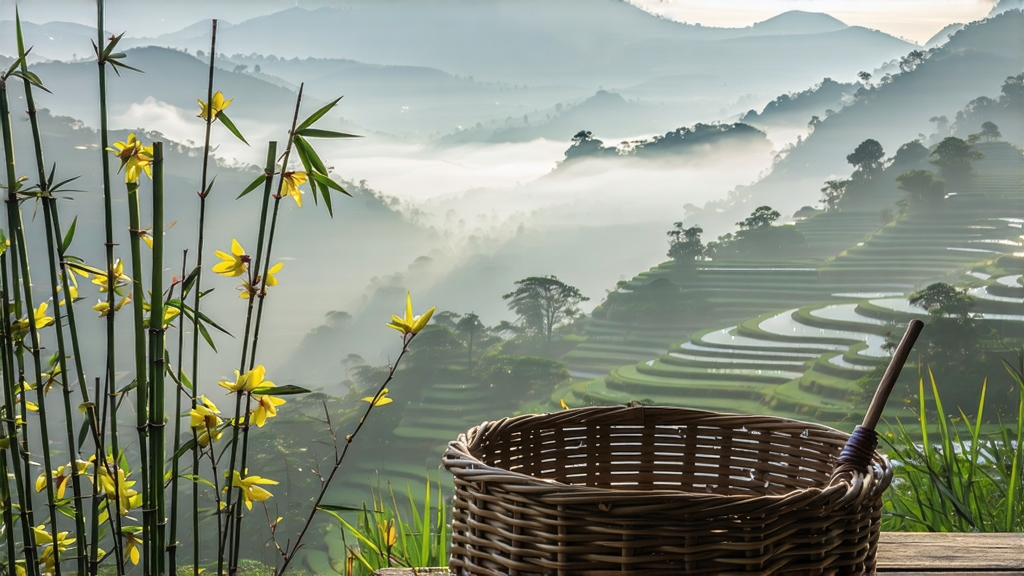
If green tea is the fresh-faced youth of Chinese tea and pu-erh the venerable elder, then yellow tea is the discreet scholar who appears only when the library doors are half-closed. Among the scant yellow teas still crafted today, Meng Ding Huang Ya reigns as both the earliest recorded and the most elusive. Grown on the summit of Meng Ding, the “Rain-Tea Terrace” that Confucius’s disciple Meng Ke once climbed to observe ritual sprouting, this bud-only tea was tribute during the Tang dynasty and again under the Qing, yet never left China in meaningful quantities. Its story is therefore one of imperial secrecy, Daoist mountain mists, and a labor-intensive micro-fermentation that turns jade into topaz without ever allowing the leaf to know real oxidation.
History: From Altar to Obscurity
Meng Ding’s tea canon begins in 53 BCE when the Daoist Wu Lizhen planted seven tea bushes on the summit, an act still commemorated by a stone altar. By 724 CE the Tang court had decreed that only buds picked before Qingming, carried by horse and palanquin along the Jiannan Road, were pure enough for the ancestral temples. Song chronicles praise the tea’s “three yellows”—yellow bud, yellow liquor, yellow leaf bottom—while Ming scholars complain that counterfeiters dyed green tea to mimic the color. After 1911 the tribute system collapsed, and the skill of “men huang” (sealed yellowing) survived only among a handful of Buddhist monks who considered the process meditation rather than commerce. When China re-opened in the 1980s, state agronomists tracked down octogenarian master Yang Zikai, who could still recall the 72-hour wrapping rhythm taught by his abbot. Today less than 800 kg of authentic Meng Ding Huang Ya reach market each spring, most pre-sold to collectors in Chengdu and Shanghai.
Micro-Terroir: Cloud Forest in a Cup
Meng Ding peak rises 1 456 m above the Sichuan basin, trapping a 92 % average humidity that forces tea bushes to grow slowly, thickening cell walls and concentrating theanine. Morning clouds filter UV light, so buds remain pale, almost translucent, containing 5.8 % amino acids—double the level of neighboring lowland gardens. The soil is a loose purple sandstone rich in selenium and vanadium, elements that later catalyze the honey note during yellowing. Because frost can occur even in April, only the hardiest old-tree clones (Camellia sinensis var. sinensis ‘Ganzi #9’) are retained; they send out a single fat bud sheathed in two glabrous leaves whose downy reverse already glows primrose.
Pluck: One Bud, One Heartbeat
The picking window opens at dawn on the 20th of March and closes precisely 72 hours later. Workers climb 2 000 stone steps wearing cotton gloves to avoid finger-oil on the bud. The desired standard is “one bud just hooking,” meaning the unfurling leaf is still shorter than the bud itself. Anything longer is rejected, anything shorter lacks the enzymatic payload required for yellowing. A seasoned picker gathers barely 200 g per hour; 60 000 such buds make one finished kilo.
Craft: The Secret Breath
Meng Ding Huang Ya is not merely green tea with an extra step; it is a choreography of heat, moisture, and suffocation that must be arrested at the exact moment chlorophyll breaks down into pheophytin without drifting into true fermentation.
- Sha Qing (Kill-Green) – 160 °C on bronze wok for 90 seconds, enough to denature polyphenol oxidase yet leave 15 % residual moisture so the bud remains pliable.
- Re-Nie (Hot-Rubbing) – Immediately the leaf is rolled between two hemp cloths; the gentle bruising fractures cell walls, releasing amino acids while keeping cuticle intact.
- Men Huang (Sealed Yellowing) – The critical, eponymous phase. Buds are wrapped in two layers of yellow silk paper, then stacked inside a bamboo steamer whose cavity has been pre-warmed to 38 °C. Every two hours the bundles are unwrapped, fluffed, and re-wrapped; the internal temperature must hover between 32–35 °C, the relative humidity above 85 %. Over 72 hours the leaf slowly suffocates, turning from jade to old ivory, while catechins dimer